

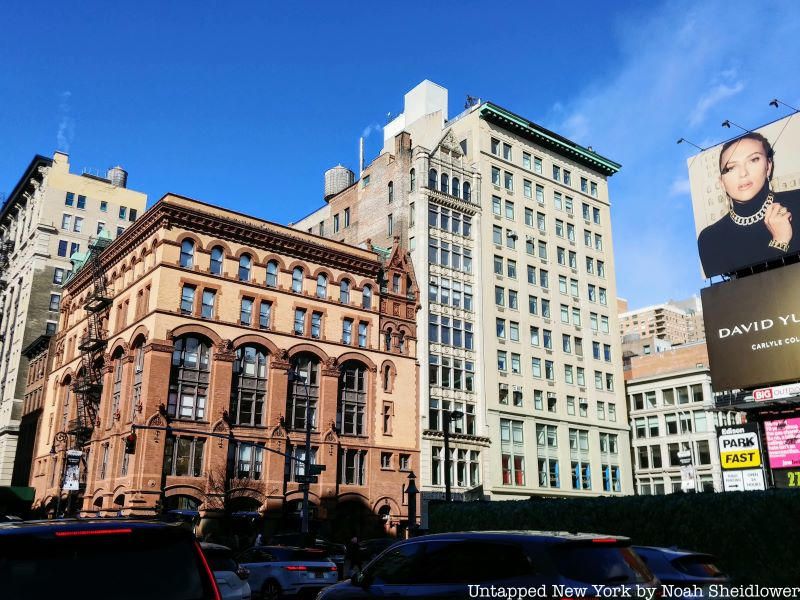
The Manhattan neighborhood of NoHo is small but packed with gorgeous architecture, public venues for theater and the arts, and a vibrant history that encompasses progressive social and political change and pioneering developments in medicine. Short for “North of Houston,” the neighborhood is roughly bounded by Houston to the south, Astor Place to the north, Broadway to the west, and the Bowery to the East. Even with an average monthly studio rent of $4,000, the neighborhood is a desirable place to live, NoHo’s small size and central location have recently attracted famous celebrity residents such as Gigi Hadid, Britney Spears, and Kristen Stewart. NoHo’s storied history reflects a neighborhood in constant evolution.
Built as a wealthy enclave for prominent New York residents in the early 1800s, NoHo by the end of the 19th century had become primarily a warehouse and manufacturing district. It wasn’t until the mid-20th century when NoHo’s lofts became off-the-beaten-track havens for artists such as Andy Warhol, Jean-Michel Basquiat, Robert Mapplethorpe, and Robert Rauschenberg that NoHo began to resemble the vibrant district it is today. Read on to discover 10 secrets of NoHo.
1. One of America’s biggest bank heists happened in NoHo
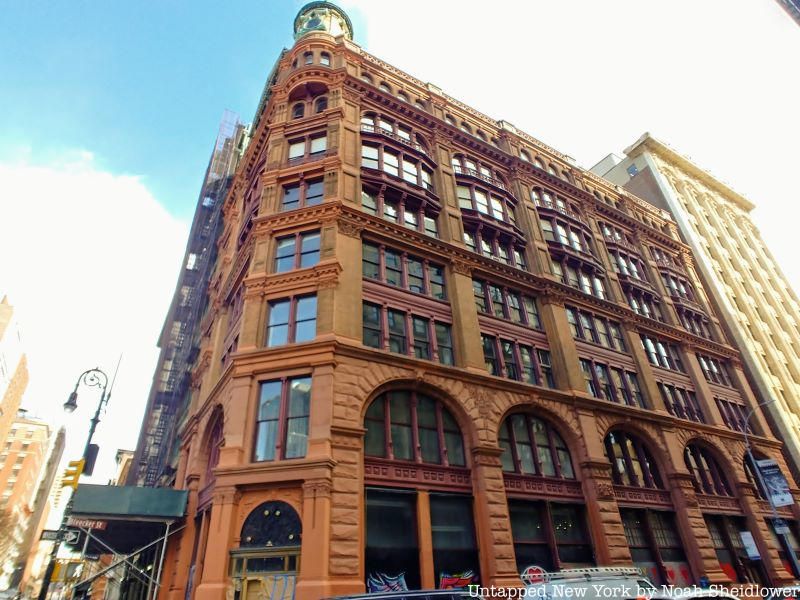
On October 27, 1878, the six-story Manhattan Savings Institution at 644-646 Broadway and the corner of Bleecker Street was the subject of one of the largest bank robberies in U.S. history. In the 19th century, the institution was one of the largest banks in the world, safeguarding the money and valuables of prominent citizens such as Andrew Carnegie and John D. Rockefeller. Its vaults and security systems were considered to be some of the nation’s most complex, posing a tantalizing challenge to bank robbers eager to strike it rich.
At around 6 a.m., a gang of seven thieves organized by the “King of the Bank Robbers” George Leslie burst into the apartment of bank janitor Louis Werckle. The gang seized the janitor’s keys to the bank and the combination to the safe. The robbers made off with $2.8 million in cash and securities, equivalent to $80 million in today’s money, before being apprehended six months later. Today the building’s replacement, the new eight-story brownstone Manhattan Savings Institution designed in 1891, stands at the scene of the crime.
2. NoHo was home to the nation’s first all-female hospital
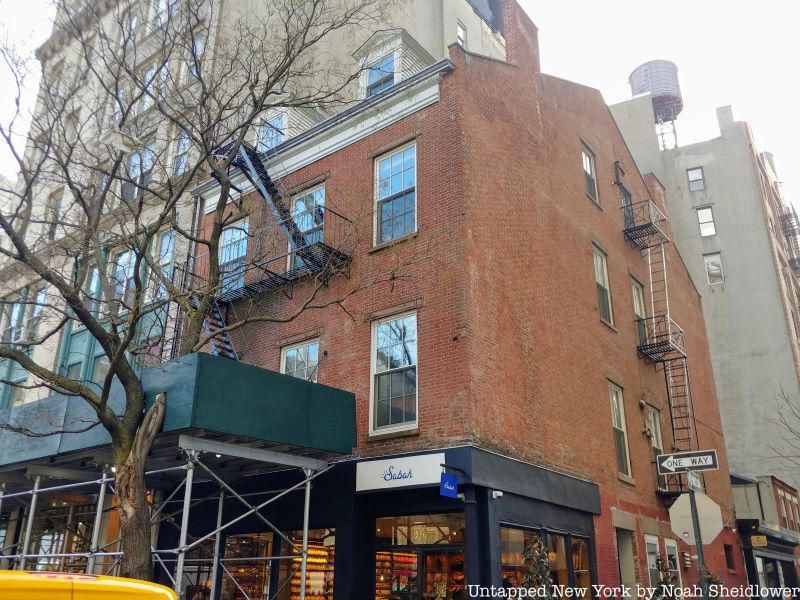
On May 12, 1857, the nation’s first hospital employing an all-female staff opened in a red brick building at the corner of Crosby and Bleecker Streets. The New York Infirmary for Indigent Women and Children was founded by the first woman in the United States to receive a medical degree, Elizabeth Blackwell, and her sister Emily. Blackwells’ mission for the infirmary was to “allow women to consult doctors of their own sex, free of charge; to provide the growing number of female medical students with the practical experience denied them by established hospitals; and to train nurses.”
The infirmary offered free medical care to poor women and children and clinical experience and instruction to women training as physicians. The infirmary featured a dispensary, two inpatient wards and a maternity ward, and bedrooms for staff and students. The Blackwell sisters would go on to found their own medical school in 1868, the Woman’s Medical College of the New York Infirmary, which graduated more than 350 female physicians over its thirty-one years in operation. Located at 58 Bleecker Street, the building features a plaque installed in 2018 by Village Preservation establishing the historical significance of the site. In Untapped New York’s On-Demand Video Archive, you can catch a talk with The Doctor’s Blackwell author Janice Nimura. The video archive holds over 150+ recordings of past events and is free to all Untapped New York Insiders.
3. Artist Jean-Michel Basquiat’s Apartment is For Sale
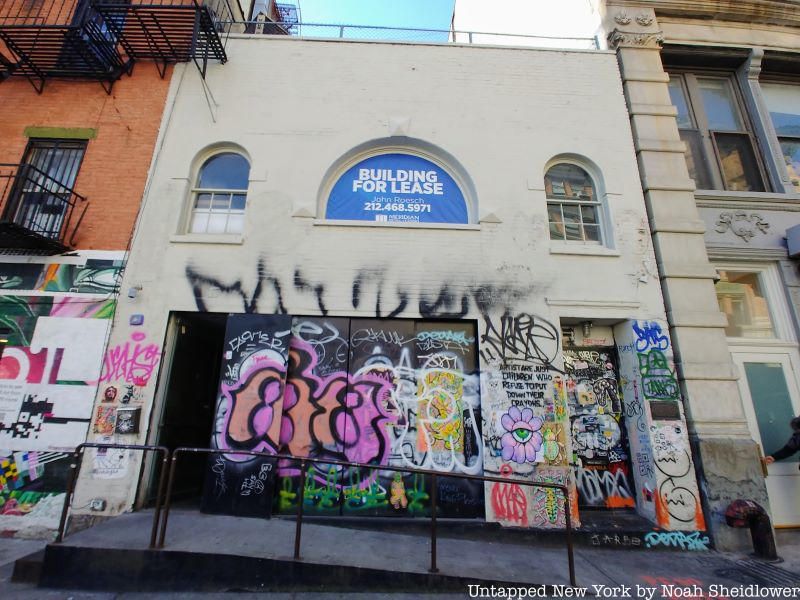
57 Great Jones Street was built between 1860 and 1868 as a horse stable and later served as a furniture store and auction house, a mob headquarters, and a Japanese restaurant. What it’s most famous for however is being the home of artist Jean-Michel Basquiat. In 1970, Andy Warhol purchased this building and another building around the corner at 342 Bowery. Warhol leased 57 Great Jones Street to his artistic collaborator Jean-Michel Basquiat. Basquiat used the space as both a home and a studio. Basquiat’s work famously challenged conventional standards of high and low art, race, and class, and incorporated his distinctive graffiti art with Warhol’s pop culture style.
Many of Basquiat’s famous Neo-expressionist works were created in this building, which is also where he died at the age of 27 of a heroin overdose on August 12, 1988. For many years, the building’s facade was covered with graffiti paying tribute to the artist and messages from Basquiat’s contemporaries, including his tag “SAMO.” In 2016, Village Preservation installed a plaque commemorating the building as Basquiat’s former residence. As of the time of publication, the building is for sale and seeking a new commercial tenant.
4. The bricked-up doorway in the Astor Place subway station

At the intersection of NoHo, Greenwich Village, and the East Village, you’ll find the beautiful entrance to the Astor Place subway station, one of the original 28 subway stations in New York City. The station is adorned with decorative tile work and a wide array of decorative plaques. Among all of the embellishments is a sealed doorway. You’ll see it outside the turnstiles on the downtown platform of the 6 train.
Above the bricked-up doorway it says “Clinton Hall.” Clinton Hall does still exist at the triangle of Astor Place on East 8th Street and Lafayette Street. This passageway was built to provide direct access to the former Mercantile Library Of New York which was housed inside at 21 Astor Place. The building was constructed at the former site of the Astor Place Opera House. The library held more than 120,000 volumes and boasted a membership of 12,000 people. Due to its importance at the time, the library had its own entrance to the subway. The library left Clinton Hall in 1932 and moved to East 47th Street. The hall was converted into apartments in 1995.
5. The Merchant’s House Museum was Manhattan’s first landmark
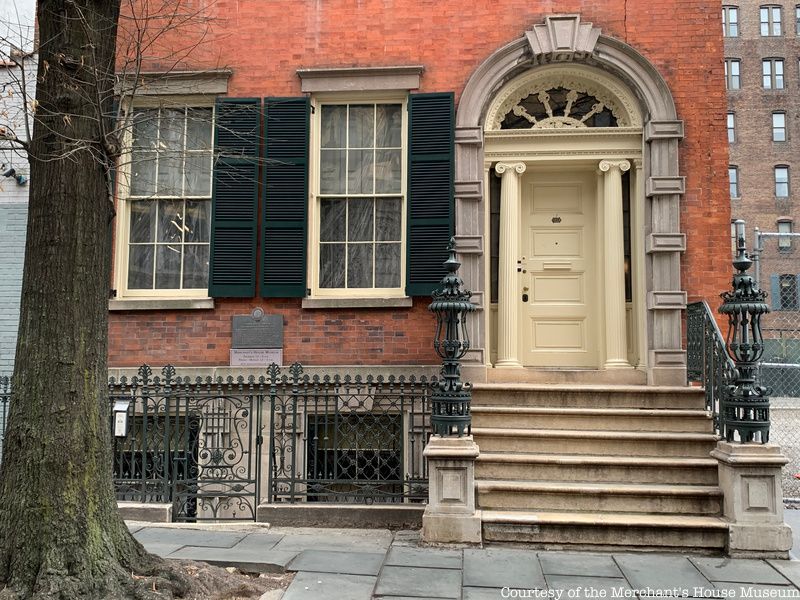
The Merchant’s House Museum at 29 East Fourth Street is a National Historic Landmark and one of the earliest New York City Landmarks. It was designated on October 14th, 1965, just a few months after New York City’s landmarks law was enacted (the very first. landmark in all of New York City was the Wyckoff House in Brooklyn). It remains the only 19th-century family house in New York City with both its exterior and interior intact as it was in the 1800s. Built in 1832 by a hatter named Joseph Brewster, the house has been restored to a mid-19th century Federal and Greek Revival style as it appeared under the ownership of Seabury Tredwell and his eight children.
Until her death in 1933, Tredwell’s daughter Gertrude occupied the house and successfully preserved its original elegance, even as the neighborhood was industrialized and nearby private homes were demolished or converted into boarding houses or tenements. Her distant cousin George Chapman purchased the building to save it from demolition, and in 1936, the restored and renovated home opened as the Merchant’s House Museum, a historic time capsule complete with the family’s original possessions.
6. The Public Theater used to be a library

NoHo has long been home to vibrant independent theaters. The Bouwerie Lane Theatre was located in a former 1873 Italianate bank building on Bond Street. In 1963, it was converted into a theater by Honey Waldman, and from 1974 to 2006 it was home to the Jean Cocteau Repertory Theatre. Among the mostly avant-garde plays it produced was Tom Stoppard’s Night and Day (2000), Bertolt Brecht’s The Threepenny Opera (2003), and Jean Genet’s The Maids X 2 (2006). Unfortunately, rising rents in NoHo led the Bouwerie to close in 2007, along with the Bleecker Street Theater in 2010.
One success story is the Gene Frankel Theatre, which was founded in 1949 and moved to 24 Bond Street in NoHo in 1989. Founded by actor Gene Frankel and directed by him until his death in 2005, the 70-seat theater helped establish the off-off-Broadway scene in New York and also served as a workshop and school. The mission of the theater has always been public-facing and progressive, as Frankel stated: “We are looking to give a home to artists that cultivate a theater that speaks not only of an idealistic socio-political change – but a personal change, the only truly manageable change that can lead to a new and better social, political, economic world.”
The Public Theater, founded in 1954 as the Shakespeare Workshop, makes its home at 425 Lafayette Street in the former Astor Library, one of the earliest public libraries in New York City. Three different architects worked on the building from 1849 to 1881. The south wing was designed by architect Alexander Saeltzer was the library opened to the public in 1845, just a few years before Astor’s death. Astro’s sons oversaw the expansions led by architects Griffith Thomas and Thomas Stent in later years.
In 1895, the Astor Library joined with the Lenox Library and established the New York Public Library. Today, the non-profit theater is an important cultural institution that serves as a launchpad for artists and plays. The Public also operates the Delacorte Theater in Central Park, where it presents the free annual summer series Shakespeare in the Park.
7. Photographer Robert Mapplethorpe had a studio in NoHo
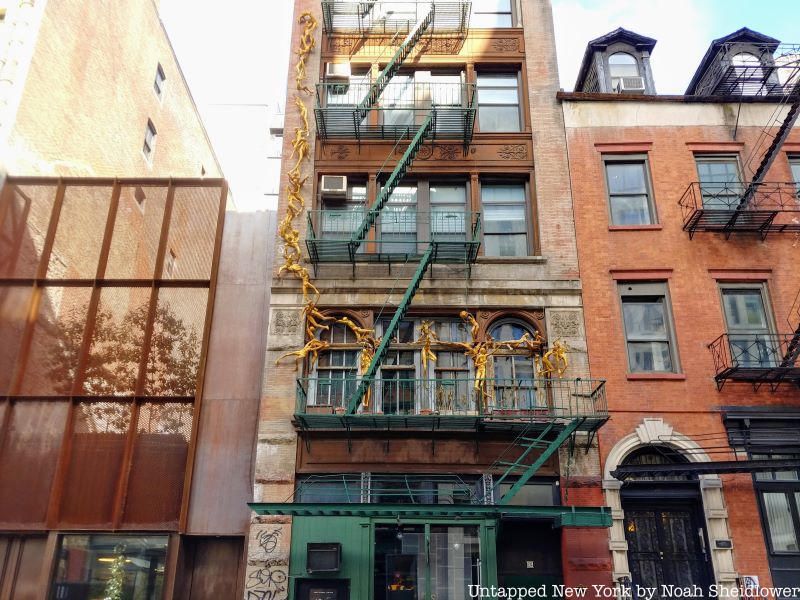
On the otherwise unassuming facade of 24 Bond Street, dozens of small golden statues dance up and down the wrought iron fire escapes and brick exterior. Artist Bruce Williams has resided in the building for over twenty years and began installing the sculptures in 1998. In 2008, 24 Bond Street was added to the NoHo Historic District Extension to officially recognize the 1893 building’s architectural significance. To celebrate, Williams added more statues climbing up the side of the building, but was required to attend an official hearing for approval because of the building’s new landmark status.
24 Bond Street enjoys an even more significant artistic legacy that precedes Williams’s sculptures. Photographer Robert Mapplethorpe occupied a studio on the fifth floor of the building from the 1970s until his death in 1989. Mapplethorpe photographed many of his famous subjects in the space, including his former lover and artistic collaborator Patti Smith, and shot their film “Still Moving” there in 1978. After Mapplethorpe’s death, the Gene Frankel Theatre moved into the ground floor of the building. The theater supports emerging actors and produces bold and progressive works, continuing to operate out of the space with a mission to support new playwrights and artists and to “revive NoHo as a cauldron of LGBTQI art and ideas.”
8. Maragret Sanger Square was “un-named”
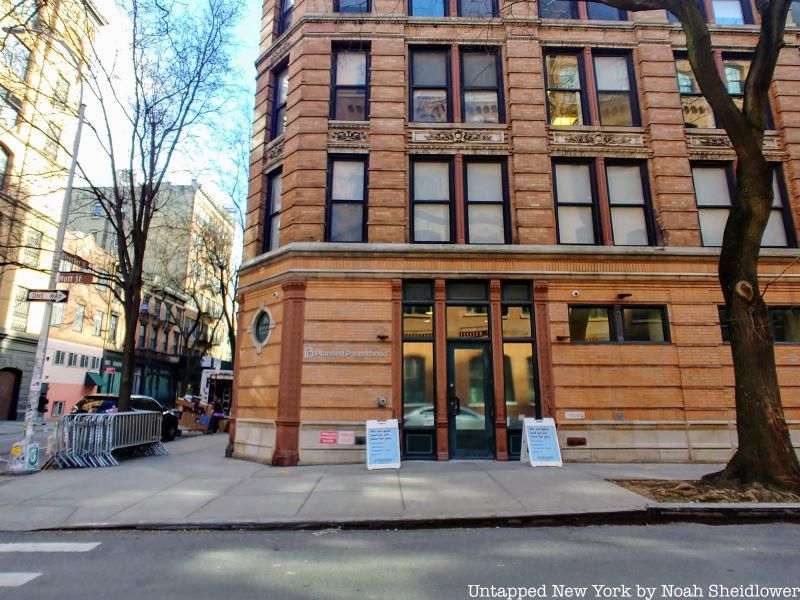
In 1916, pioneering birth control activist Margaret Sanger opened a trial clinic in Brooklyn to challenge New York State’s ban on contraception. On January 2, 1923, Sanger opened the first legal birth control clinic in America, the Birth Control Clinical Research Bureau (BCCRB), under the direction of the female physician Dr. Hannah Stone. The BCCRB established a nationwide network of affiliated clinics and worked in association with Sanger’s National Committee for Federal Legislation for Birth Control to promote contraceptive instruction in public health programs. In 1940, the BCCRB became the Margaret Sanger Research Bureau before becoming Planned Parenthood of New York City in 1973. In 1997, Planned Parenthood’s headquarters, the former Margaret Sanger Health Center (now the Manhattan Health Center), relocated its clinical facilities to 26 Bleecker Street.
In recent years, Planned Parenthood has worked to distance itself from Sanger due to Sanger’s support of eugenics. Sanger’s name was removed from the Manhattan health clinic and the organization requested that the City “un-name” Margaret Sanger Square. The New York City Council approved the removal of the Margaret Sanger Square street sign in December 2021.
9. NoHo was home to an English-inspired pleasure garden
In 1748, the Swiss physician Jacob Sperry founded New York’s first botanical garden near the present-day intersection of Lafayette Street and Astor Place. A mile from the edge of the city at the time, Sperry’s gardens featured flowers and hothouse plants and became a destination for weekend travelers strolling up the former Broad Way from Wall Street and the City’s Common, located at present-day Chambers Street. In 1804, Sperry sold the property to John Jacob Astor, who leased it to a French entrepreneur named Joseph Delacroix.
Delacroix built a country resort named Vauxhall Gardens on the site. Named after a famous garden in England, the spot became a fashionable destination where New Yorkers could eat, drink, socialize, watch plays, listen to live music and be entertained by fireworks in the evening. It was also a place where you could see hot air balloon ascensions, a popular attraction of the time. By 1825, when Delacroix’s lease was up, the property values had skyrocketed on nearby Bond, Bleecker, and Great Jones Streets. Astor realized the value of the real estate the garden occupied. He cut a broad street across the garden to create Lafayette Place, which was named by the Marquis de Lafayette himself on his last visit to New York in July of 1825. This street cut the garden in half and became a popular residential thoroughfare after the construction of LaGrange Terrace.
10. The Lost Mansions of Bond Street
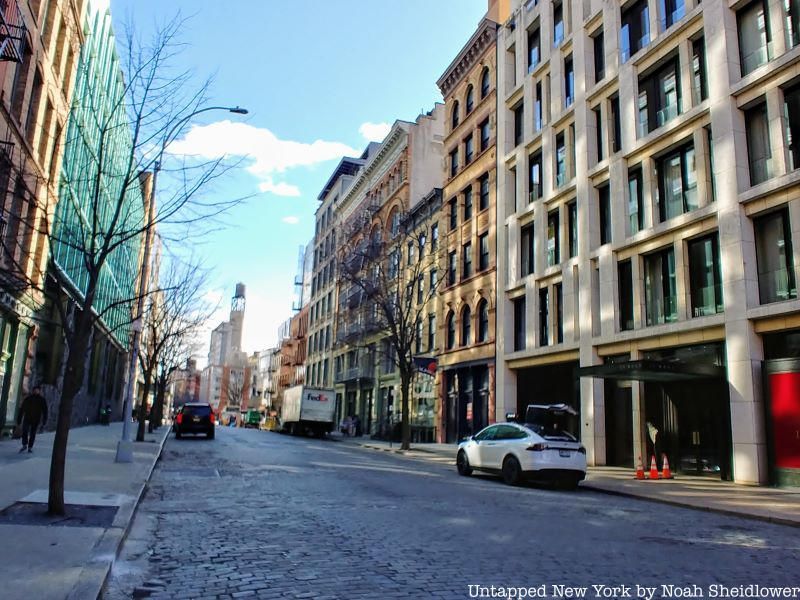
In the 1820s, Bond, Bleecker, Great Jones, and Lafayette Streets were some of the most fashionable addresses in the city. In addition to Lafayette Place, mansions sprang up in the neighborhood for wealthy residents. Astor built the Astor Library as a donation to the city, and Alexander Jackson Davis designed ornate Federal-style row houses called LaGrange Terrace, now known as Colonnade Row.
In its heyday, the neighborhood was home to notable residents including the aristocratic mayor Philip Hone, the Astors and Vanderbilts, and the authors Washington Irving, Charles Dickens, and William Makepeace Thackeray. In addition, U.S. President John Tyler was married in one of the fashionable mansions in NoHo. Wealthy residents such as the poet William Cullen Bryant and the inventor Isaac Singer lived there through the 1880s, but by the end of the century, the neighborhood had become primarily a warehouse and manufacturing district. Greek Revival terracotta and brick loft-style buildings began to replace wealthy residences, and in 1902, the southern five mansions on Colonnade Row were demolished to clear space for Wanamaker’s Department Store. The last mansions on Bond Street, however, continued to last until the 1930s.
Next, check out the Astor Place Riot and The Remnants of NYC’s Cat Alley

